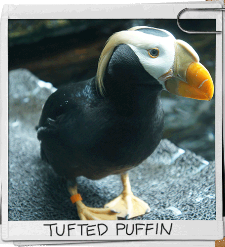Puffins
 |
| http://www.seattleaquarium.org/puffin |
Not only are they colorful but they are also really interesting.
Before I start to talk about how special puffins are, let's review a few things about birds in general.
Birds are quite different from fish, marine mammals, and invertebrates. Birds have a backbone just like fish and mammals do, but not like invertebrates. Birds are warm-blooded and breathe air with lungs like mammals, but not like invertebrates or fish. Birds have wings, a beak, feathers that cover their body and they lay eggs. Most birds can fly but some birds can’t, and a few birds can even swim!
 |
| http://www.pdza.org/tufted-puffin/ |
Puffins are excellent divers since they spend most of their time in the water. They hunt for bait balls of small fish or for squid. Puffins are able to hold many fish in their beak at once because they have small teeth like structures on the top of their mouth and a raspy tongue. This is important because puffins have to travel long distances to get to good feeding areas. Being able to carry many fish at once in their beak helps them conserve energy. They are also known to always eat the fish head first, so fish spines don't poke them.
 |
| Tufted Puffin holding many fish in its beak |
Stay tuned for a fun puffin mask art project coming soon!
Sources:
http://www.seattleaquarium.org/puffin
http://www.pdza.org/tufted-puffin/
Puffin Art Project
This Puffin mask art project is super fun to make and kids will be able to enjoy being puffins throughout the day!
This Puffin mask art project is super fun to make and kids will be able to enjoy being puffins throughout the day!
 |
| Puffin mask made by M.U. |
Materials :
· Half face black mask
· White, orange, black, yellow & red construction paper
· Small orange poms
· Templates
· Glue sticks
· Scissors
· Hot glue gun w/ sticks
 |
| Puffin masks made by Seattle Aquarium campers |
Directions:
1. Print out the templates and trace them onto appropriate colored paper.
 |
| beak templates |
2. Cut out all the pieces including the triangles for the eyes.
3. Hot glue the white eye pieces onto mask.
4. Fold the beak pieces in half diagonally.
5. Glue the beak pieces together by superimposing them. Beak color order should be red onto yellow onto black onto orange.
 |
| color order for beak |
6. Hot glue the beak onto the mask.
7. Hot glue one small orange pom on each side of the beak
Enjoy being Puffins!
Puffin Storytime
It was a real struggle to find a good book about puffins until I found "Puffin Peter" by Petr Horacek.
 |
| Puffin Peter by Petr Horacek purchased from the Seattle Aquarium Gift Shop |
This is a beautifully illustrated lost-and-found story. Children will get transported into a great adventure while meeting different bird species from all over the world. The striking artwork of birds, the ocean and islands are a real treat for little eyes. This dramatic plot and happy ending also makes this a great book for bedtime reading. I highly recommend it!


Comments
Post a Comment